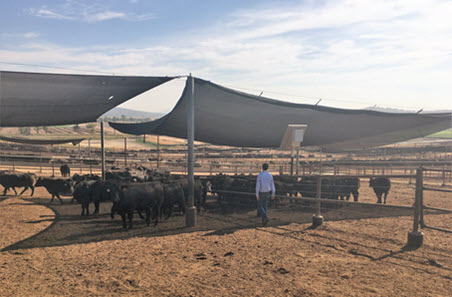Research targets dark cutting
 The impact of lairage timing and duration on the meat colour of feedlot cattle is the focus of new research aimed at reducing rates of dark cutting in the industry.
The impact of lairage timing and duration on the meat colour of feedlot cattle is the focus of new research aimed at reducing rates of dark cutting in the industry.
Feedlot veterinary and nutrition consultants, Matt and Melissa George, Bovine Dynamics, are undertaking the project, funded by grainfed levies through Meat & Livestock Australia (MLA) and the Australian Lot Feeders’ Association (ALFA).
Looking into the effects of lairage and transport
The project’s objective is twofold – determine the effect of time of dispatch from the feedlot and duration of lairage at the abattoir, on rumen physiology, muscle glycogen, and carcase characteristics.
The depletion of muscle glycogen reserves due to reduced dietary glucose precursors and/or physiological stress are the primary factors associated with dark cutting.
Matt and Melissa said while muscle glycogen concentration is maximised prior to departure from the feedlot, the period of time from feedlot dispatch to slaughter may impact muscle glycogen concentration at slaughter which is an important factor associated with meat colour and ultimate pH.
Their hypothesis is that cattle exposed to longer periods of transport and lairage will have higher ruminal pH, higher ruminal temperature, higher ultimate pH, reduced muscle glycogen levels, and darker meat colour.
Matt said it was hoped the project’s findings would help guide future recommendations for best practice dispatch and lairage of grainfed cattle.
“Most people in the industry have a reasonable knowledge of what contributes to dark cutting, but quantification of it within the context of both cattle time off feed and lairage time is required,” Matt said.
“An hour at home in the feedlot is not necessarily the same as an hour at the processing plant. With modern transport systems and improved infrastructure, there’s an opportunity to re-examine our lairage systems to address dark cutting.
“For a lot of reasons, especially animal welfare, we believe we can reduce lairage times for some cattle and get meat quality outcomes at the same time.”
Data from the field
Melissa said their in-field research, conducted through a well-established supply chain involving a NSW feedlot and processing facility, is now complete and data analysis is underway.
“Our research involved 400 head of cattle of a similar breed type and weight,” Melissa said.
“We examined two dispatch times from the feedlot – the afternoon before and morning of slaughter; and two slaughter times – morning slaughter and afternoon slaughter.
“This research has generated information that will empower the feedlot industry to make more informed decisions about transportation and lairage.”
Data collected after slaughter included full Meat Standards Australia (MSA) measures, and both subjective and objective meat colour measurements. Weather data will also be incorporated in the analysis.
Matt said that they’re also looking at the effects on total live weight shrink or carcase shrink, which can have a profound impact on economics.
“We’ll know kill times, when they were graded and duration of chiller time they had,” he said.
“We’re worried some cattle might not always achieve ultimate pH and therefore, getting assigned a dark cutting grade is not necessarily the fault of the cattle or the general plant’s slaughter conditions, it’s actually potentially a chilling duration issue.”
The researchers are also using rumen boluses in some of the cattle to measure rumen pH, temperature, and activity level, which will allow them to compare cattle in lairage to cattle back at the feedlot.
“From a rumen fermentation standpoint, we can use rumen pH to determine if cattle exposed to longer lairage times are running out of fermentable substrate prior to slaughter,” Melissa said.
The data generated from the rumen boluses will be compared to slaughter data including meat colour, muscle glycogen, and MSA grading.
Results from the project will be available later this year.
For more information, contact:
Dr. Joe McMeniman
Project Manager – Feedlot
Email Dr. Joe McMeniman



